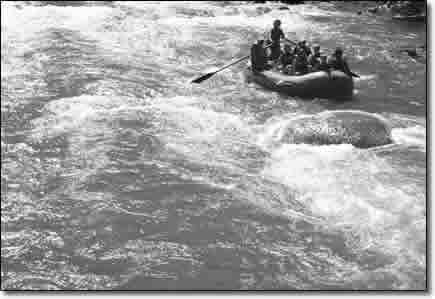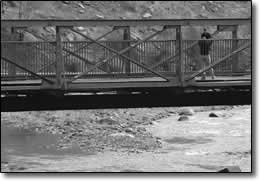|
Legislation could trade recreation for development

|
|
A commercial raft trip floats the Animas River through town last summer. A bill making the rounds in the state legislature would make recreational in-channel diversion water rights, or RICDs, junior to all other water rights and subject to a 350 a cap. Several Colorado towns already use RICDs for whitewater parks and Durango is considering the option. However, opponents of the bill say it would jeopardize RICDs as well as Durango's chance of securing future flows for recreation and fish habitat./Photo by Todd Newcomer.
|
by Missy Votel
Recreational river users, locally and statewide, are mobilizing against proposed legislation
they say could severely jeopardize the future of whitewater recreation, if not the state's entire river system.
Senate Bill 62 was drawn up earlier this year by Steamboat Springs Republican Jack Taylor. As put forth by Taylor,
the bill would seek to level the playing field among all water users and fix problems created by 2001's Senate Bill
216. That bill laid out parameters for recreational in-channel diversions, or RICDs, water rights for on-stream uses
such as whitewater parks. Since it passed, a handful of municipalities have taken advantage of RICDs, including Vail,
Golden and Breckenridge. The City of Durango, with the guidance of the
Animas River Task Force, a consortium
of river users, is studying the idea. However, Taylor's bill would make such RICDs junior to all other water rights
in order to "protect Colorado's water rights and practices" and ensure water availability "to develop and use the
state's water compact in the future."
While Taylor stresses that the point of the bill is not to injure the state's growing water recreation industry,
boaters, outfitters, environmentalists and anglers across the state are crying foul.
"It's gutting the RICD as it stands," said Buck Skillen, a fishing guide and president of the local chapter of Trout
Unlimited. "My stance as far as our chapter, and as a member of the Animas River Task Force and resident of the city
of Durango, is that it's a terrible idea."
Among opponents' main gripes with the bill is that it takes a one-size-fits-all approach, capping the maximum amount
of RICDs to 350 cubic feet per second.
"Three-hundred-and-fifty cfs really isn't adequate for recreation," said Brian Brown, a local kayaker and member of
the Animas River Task Force. "It isn't even enough to get a raft down, let alone a kayak. It's not healthy for fish,
and it's not enough for other forms of recreation."
Opponents also take issue with the bill's requirement that all RICDs have some sort of "control structure" in place.
The bill defines this as a structure consisting of "sides and a bottom, constructed by humans and used to control
water in its natural course." However, Brown said such a structure would likely result in diverting water out of the
river and down a kayak course or a dam upstream of the course.
"It's the antithesis to in-stream flow to build a diversion structure," he said.
Furthermore, the bill is so limiting that is may defeat the city's efforts to secure an RICD for the Animas River all
together.
"I think the bill punishes Durango for taking a moderate, wait-and-see approach," said Kent Ford, another local
boater and member of the river task force. "Now there's a good chance that anything in the future will be severely
cramped. It's despairing."
Facilitating future development
Beyond technical arguments with the bill, opponents charge it will have repercussions that flow far beyond
recreation.
Although Mark Pearson, executive director of the San Juan Citizens Alliance, called SB 62 a "slap in the face of
recreation," he said it simply is a thinly veiled attempt to pave the way for future development.
"The bill's intent is absolutely to protect future development," he said. "Water rights are sacrosanct until someone
actually uses their rights for environmental purposes."
According to Pearson and others, beyond ensuring future river recreation, RICDs will play a key role in simply
ensuring there's enough water in the river.
"A natural flow in the Animas River is necessary to sustain fish, aquatic life, riparian vegetation and so on," said
Dave Wegner, a member of the task force.
Opponents also fear a hidden agenda with SB 62, one of a "little straw" inter-basin transfer that would divert water
from the Animas to the thirsty Front Range.
"My biggest fear is that someone gets an idea for a dam up on the High Line above Rockwood," said Trout Unlimited's
Skillen.
In addition to drying up the river, opponents also worry that in so doing, SB 62 will dry up the very economy that
supports towns such as Durango. According to the Colorado River Outfitters Association, the river recreation industry
has been growing by leaps and bounds over the last 15 years. Last year, river rafting was a $44.5 million business in
Colorado, with the Animas River accounting for $4 million of that, coming in third behind the Arkansas River and the
Colorado River through Glenwood Canyon. This is in sharp contrast to other, consumptive uses of water, such as
agriculture, which brought in just a fraction of that.
"Recreation and tourism pays the freight," said Skillen. "We've got to have ag and open space, but tourism and
recreation play a bigger role."
Even so, Brown argues that RICDs wouldn't hurt farmers, who already have senior water rights. However, like Pearson,
he fears such rights will be used not to plant alfalfa but subdivisions.

|
|
2-year-old Nikolay Bohachevsky gets a better view of the Animas River with the help of mother, Laura Bohachevsky, on the pedestrian bridge south of Santa Rita Park on Monday. Opponents of SB 62 argue it funnels water rights to development which could eventually dry up the river./Photo by Todd Newcomer.
|
Even so, Brown argues that RICDs wouldn't hurt farmers, who already have senior water rights. However, like Pearson,
he fears such rights will be used not to plant alfalfa but subdivisions.
"You can make millions by subdividing, and that's what I see happening," he said.
However, Wegner points out that by drying up rivers, SB 62 could starve the very development it is trying to feed.
"Without the river, recreation and development would go away because I don't think people would see Durango as such a
desirable place to live anymore," he said.
Jumping through hoops
Sen. Jim a, D-Hesperus, supports SB 62 and was the deciding vote in passing the bill out of committee last week with
a 4-3 vote. The bill is expected to go to a full vote by next Wednesday. Isgar argues, among other things, that the
bill merely streamlines the RICD filing process, in some cases making it easier for cities to obtain recreational
water rights.
"There's a lot of misinformation about what the bill does," he said Monday from Denver. "It makes filing simpler."
He said the bill is necessary to provide more "statutory direction" in the creation of RICDs. So far, every filing
for a RICD since the 2001 law has ended up in water court he said, which can cost municipalities upwards of $50,000.
He said some of the recurring themes in these cases are control structures, when to make a call on water and amounts,
all things SB 62 attempts to address.
Furthermore, he said the bill will help ease the burden on other water rights holders, who are faced with legal
problems and "jumping through hoops" anytime RICDs are filed.
Isgar said the 350 cfs maximum was based upon justification from people that a whitewater course could be built at
that level. He also pointed out that although 350 cfs is seen as the maximum amount of an RICD, it really is quite
the opposite.
"It's called the maximum, but it's really the minimum amount of water that will be in the river, because any flow
above and beyond that that isn't allocated can be used," he said.
He also said that the demand for control structures is not an attempt to create more hurdles for RICD water right
holders but a way to make sure they are playing by the same rules as all other holders.
"Anyone with a water right needs to control it and prove it is going to its intended use," he said. "You need to be
able to control that 350 cfs to call it. If you can't control it, you shouldn't be able to use it."
As far as fears of SB 62 drying up the river, Isgar said they are unfounded.
"I know a lot of it is driven by fear that the water may go somewhere else, but I don't see that happening," he said.
"If the only way to protect rivers was RICDs, I'd be leading the cause."
Furthermore, he said development elsewhere in the state will all but guarantee Animas flows, which will be needed to
go downstream to fulfill Colorado's interstate water compact. "It means our water will pretty much have to stay in
the river," he said. think the flow on the Animas is pretty well protected."
However, if left unchecked, RICDs could endanger this, he argued, by turning the typically abundant Animas into a
"water-critical" situation, creating a logistical head-ache for all water rights holders.
Despite all the arguments for and against the bill, Isgar said in closing that in the greater scheme, it likely will
have little or no effect on recreation on the Animas.
"As a practical matter, RICDs would not change in any noticeable way on the Animas River," he said. "The river will
run just like it does. I've always been supportive of tourism and recreation, this does not have to conflict with
those needs."
Brown, with the Animas River Task Force, agrees that the bill likely won't have a huge impact locally - at least for
the short term.
"It's not a huge, critical issue for the Animas River," he said. "But I see it as a legacy. Securing in-stream water
rights just means that in 50 years, 20 maybe, that we've got that right, and no one's going to be drying up our
river."
|